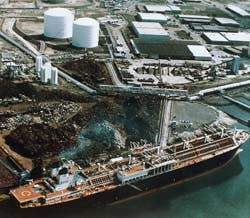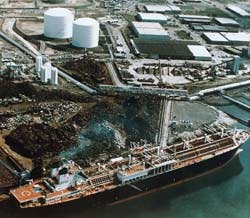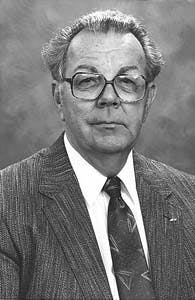Edward J. Swain
Consultant
Houston
An LNG tanker is docked at Distrigas' LNG receiving plant at Everett, Mass. (LNG storage tanks appear in the upper left.)Imports of LNG into the U.S. in 1995 were the lowest since 1988, when 17.5 billion cu ft were imported.
Total 1995 LNG imported from Algeria was 17.92 bcf compared to 50.78 bcf in 1994, a decrease of 64.7%. About 72% of imported Algerian LNG was received at the Distrigas Corp. terminal north of Boston. The remaining LNG was received at the Trunkline LNG Co. terminal, Lake Charles, La., which was reopened in December 1989. Trunkline LNG is a subsidiary of PanEnergy Corp., Houston.
The dramatic decline in LNG imports over the past 2 years (78%) can largely be attributed to Sonatrach's multiyear renovation project to restore its LNG plants to their original capacities. This major renovation project has resulted in LNG export curtailments to all of its customers.
As renovations are completed, Sonatrach will increase LNG exports. Total completion of its renovation project, however, is not expected until sometime later this year.
Notwithstanding the scheduled completion date, imports of Algerian LNG into the U.S. will have increased somewhat in 1996. First, Algeria's current LNG export capacity has been restored to its levels at the start of its renovation project.
Second, Gazoduc Magh reb Europe (GME), the 807-mile gas pipeline from Algerian gas fields to Cordoba, Spain, began operations in November of last year (OGJ, Dec. 2, 1996, p. 50). An additional 311 miles of line are under construction from Spain into Portugal. Completion of the entire pipeline will free up more LNG export capacity, Spain currently being Algeria's second largest LNG customer.
The total value of LNG imported was $35.7 million in 1995 at a yearly average price of $1.99/Mcf. The 1994 yearly average price was $2.28/Mcf; therefore, the imported LNG price decreased 12.7%.
U.S. terminals
The four existing LNG receiving terminals located along the U.S. East and Gulf Coasts are shown in Table 1 [12897 bytes].
After being shut down in 1987, the Distrigas terminal restarted in 1988 to receive LNG. Quantities imported through it during 1991-1995 and forecast through 2001 appear in Table 1; the data are illustrated in Fig. 1 [21264 bytes].
The terminal received 12.77 bcf (five shipments) during 1995 as a result of the curtailment by Sonatrach. The five shipments were received in January, March, August, November, and December of 1995. The terminal received 12.78 bcf (five shipments) during the first half of 1996, and it is assumed the total yearly rate for 1996 will be 25.6 bcf.
The Distrigas terminal primarily serves customers in New England. In the past, delivery of LNG from the terminal was mainly by trucks and some distribution by pipeline. New tie-ins to several local major natural-gas pipelines and new industrial contracts, however, have made major delivery changes in Distrigas' operations.
A 20% annual growth rate is assumed, using the average of LNG imported during the 1992-1996 period as a base and extending the forecast period to 2001. Under this growth assumption, the Distrigas terminal is only utilized 64% in 2001.
Trunkline LNG's Lake Charles terminal, reopened during 1989, received one shipment of LNG from Algeria in December 1989. The quantities of LNG imported through the terminal during 1991-1995 and forecast quantities through 2001 appear in Table 1; the data are illustrated in Fig. 1.
The terminal received 5.14 bcf (two shipments) during 1995. One shipment was received during the first quarter 1995; the second, in second quarter 1995.
The terminal received 1.96 bcf (one shipment) during first half 1996; it is assumed the total yearly rate for 1996 will be 3.9 bcf.
The terminal is able to move vaporized LNG into many major natural-gas trunk lines serving customers all along the middle and upper East Coast and in the central Great Lakes. In recent years, the natural-gas pipeline serving growing gas markets in Florida was expanded in deliverable capacity.
Vaporized LNG from Lake Charles was to supply the additional natural-gas demands in the Florida market. If any additional gas demands have occurred in Florida, gas supplies from offshore gas fields near Mobile have met the demands.
New production facilities at offshore fields and additional distribution systems are being installed and will supply up to 1.2 bcfd of treated natural gas to serve Florida.
Although a 20% annual growth rate for importing LNG is assumed to take place in the lower Atlantic markets, the Lake Charles LNG receiving terminal is only utilized about 12% by 2001.
In late 1995, Cove Point LNG Ltd. partnership began commercial operation for peak shaving and storage at its Cove Point, Md., LNG terminal. The liquefaction unit produces LNG from pipeline gas at a rate equal to 15 MMcfd of natural gas.
The partnership consists of units of Columbia Gas System Inc. and Potomac Electric Power Co.
When fully operational, the complex will have 5 bcf (gas-volume equivalent) in storage and a delivery capacity of 1.2 bcfd on a 2-hr notice.1
Southern's LNG terminal at Elba Island, Ga., will not be operating through 2000.
Base-load producers
LNG base-load plants in Algeria currently provide LNG to the U.S. in supply contracts that cover 1998 and into mid-1999.
The LNG base-load plant in Trinidad appears to be moving ahead as the engineering-procurement-construction (EPC) contract was signed in mid-year 1996 (OGJ, Dec. 16, 1996, p. 12). Current time schedule calls for the LNG plant to be operational by mid-1999.
It appears that LNG output will be marketed into New England as well as Portugal and Spain.
The proposed LNG base-load plant in Nigeria may be finally getting off the ground after many delays. The first train is being scheduled for 2000 operations. Of the first train's output, 3% is contracted to Distrigas' Northeast U.S. operation.
A look at the project's components casts some doubt on whether the timetable is realistic. Project components include a 200 km, 938 MMscfd gas-transmission line, an LNG base-load plant at Finima with a capacity to produce 5.6 million metric tons/year of LNG, an LNG-loading jetty, two LNG-storage tanks of 84,000 cu m capacity each, and seven LNG carriers.
A group of companies (Kellogg/JGC Corp./Technip/Snamprogetti SpA) has the contract to do the engineering on the LNG plant and supporting offsites.
Furthermore, project delays may have started with the execution of nine antigovernment activists. The International Finance Corp. (IFC), the private investing arm of the World Bank, has pulled out of a $3 billion natural-gas project.
The IFC's participation would have been a $100 million loan and a 2% equity share valued at about $60 million. The project's other participants include Royal Dutch Shell, Elf Aquitane, and Agip. Royal Dutch Shell stated in November 1995 it would not back out of its investment in Nigeria.
Another potential LNG supply source to the U.S. market, the Venezuela Cristobal Colon LNG project, continues to be on hold.
LNG pricing
The projection of LNG entering the U.S. marketplace does not consider product prices of low and high-cost LNG producers. Some guidance of LNG landing prices is available, however, from Sonatrach's LNG into Distrigas and Trunkline LNG terminals which are presented in Table 2 [29229 bytes].
One needs to compare these prices against the price history of natural gas being purchased by electric utilities and industrial customers in the U.S. in which the LNG terminals are sited. These natural-gas prices are presented in Table 2.
In reviewing the price history of the two customers, electric utilities and industrial, one can estimate in what markets imported LNG can be utilized as a base-load fuel.
When any new Atlantic Rim LNG producers come on-line in the late 1990s or early 2000s, will U.S. natural-gas prices be high enough to attract new supplies of LNG? Or, will Western European customers be the home for the new supplies of LNG?
A major increase in U.S. natural-gas prices is needed to aid in attracting any new LNG producer. However, higher natural-gas prices could bring more gas in from Canada.
Exports
The Phillips Petroleum Co./Marathon Oil Co. joint venture exported 65.30 bcf from the Port Nikiski base-load LNG plant site on the Cook Inlet of southern Alaska for delivery to Tokyo Gas Ltd. and Tokyo Electric Power Co. Inc., Yokohama, during 1995.
The 1995 LNG shipments represented an increase of 4.1% over the 1994 export volume of 62.68 bcf. Expansion of the LNG facilities was performed by Bechtel during 1992-1993, making the increase in exports possible from the past average level of 53.0 bcf.
The total LNG sales revenue to Phillips and Marathon was $221.8 million in 1995, an increase of 11.4% over the $199.1 million received during 1994. The average selling price increased 7.2% from $3.18/Mcf in 1994 to $3.41/Mcf in 1995.
The 5-year shipping price history (in $U.S./million BTU) of LNG leaving Port Nikiski is as follows: 1995, $3.38; 1994, $3.15; 1993, $3.31; 1992, $3.40; and 1991, $3.67.
The Japanese have been putting pressure on all their LNG suppliers to reduce the purchase price of LNG. In 1995 six countries supplied LNG to Japan: Australia, Brunei, Indonesia, Malay sia, UAE, and the U.S. Indonesia was the major supplier at 40.4%; the U.S. supplied only 2.8%.
As energy resources imported into Japan are price indexed to world crude-oil prices and since those prices increased in 1995, the price of LNG imported into Japan increased as well in 1995.
The Phillips/Marathon joint venture signed an agreement with Tokyo Gas Ltd. and Tokyo Electric Power Co. Inc. in mid-1988 to continue LNG sales through 2004.
Under the new contract, two new LNG carriers (87,500 cu m dwt, each) will deliver about 64 bcf/year of LNG in 17 trips at maximum demand rate. Delivery at this rate was to start in 1993.
The actual and forecast quantities of LNG shipped from Port Nikiski (Table 3 [39291 bytes]; Fig. 2 [8670 bytes]) show that the contract quantity of 64 bcf/year was exceeded in 1995. The near-future capacity output will probably range between 64 and 66 bcf/year, depending on market demands.
Phillips operates the LNG plant and Marathon operates the LNG carriers. Sales and facilities' interests are split: Phillips 70%, Marathon 30%. The feed gas to the LNG unit is provided by Phillips and Marathon from gas fields in the upper Cook Inlet area.
It is assumed that the Yukon Pacific LNG project will not affect export of LNG from Alaska to Japan through 2001.
Reference
1. "Cove Point: A Step Back Into The LNG Business," American Gas Journal, December 1995/January 1996.
The Author
Edward J. Swain is an independent consultant in Houston. He is retired from Bechtel Corp., where he was a process planning engineer. Before joining Bechtel, he worked for UOP and Velsicol Chemical Corp. He has a BS in chemical engineering and an MS in business and engineering administration, both from the Illinois Institute of Technology, Chicago.
Copyright 1997 Oil & Gas Journal. All Rights Reserved.




